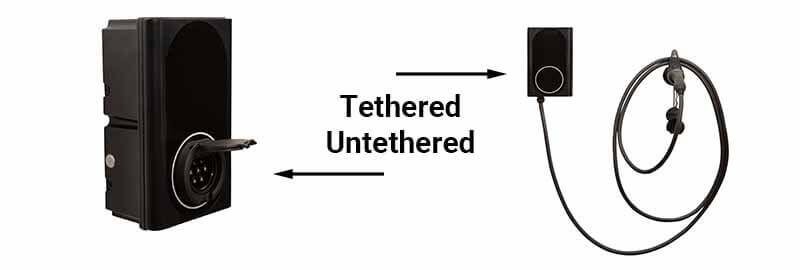Since some of the EV chargers are still only available as type 1 or type 2, let’s go through what tethered and untethered means along with the pros and cons.

Tethered EV Chargers
A tethered EV charger simply means the charging cable is permanently attached to the electric vehicle charger unit. Many customers find this more convenient as the cable is always at hand – you just need to uncoil it and plug it in to your vehicle. In this way, it is very similar to the petrol pump experience.
However, a tethered charger means you are limited to the cable lengths offered by the manufacturer, which is usually five metres as standard.
You’ll also need to ensure the cable matches your vehicle’s plug socket. This is because EVs have different plug sockets on them for charging at home – either Type 1 or Type 2 – so you have to make sure the tethered charger will “fit” your electric car in advance. It’s a bit like the different charging connections on an iPhone versus other smartphones.
Luckily, all modern electric cars are with Type 1 or Type 2 nowadays so this issue does not affect most drivers. If you do happen to have a Type 1 electric vehicle then you will need to specify a Type 1 charger if you want a tethered unit. Keep in mind that if you have visitors with a Type 2 vehicle or you decide to change your EV in future to a Type 2 vehicle then your existing unit will not be compatible.
For drivers of Type 1 vehicles, an untethered unit may be best for future proofing.
PROS AND CONS OF TETHERED CHARGERS
Pros
More convenient – simply uncoil the cable and plug in
More secure – the cable is part of the unit so it’s harder to be forcibly removed
Cable included – which may mean you do not need to purchase a charging cable separately
Cons
Lack of flexibility
Restricted to charging Type 1 vehicles only or Type 2 vehicles only
Limited choice of cable lengths
Untethered EV Chargers
An untethered EV home charger has no cable permanently attached to the unit itself. Instead it has a socket, hence why they are sometimes called “socket-only” EV chargers.
An untethered charge points will require you to plug the car’s charging cable into both the home charger and the vehicle.
They don’t usually come with a cable as standard, so you will need to source your own cable if your car does not come with one already. To be honest, we’d always recommend purchasing an EV cable anyway to keep in the boot for public charging.
An untethered charge point offers more flexibility. It can charge any electric vehicle because the socket is universal and you are also not restricted on cable length – simply measure up and buy a suitably long cable.
Some customers also think they are neater because there aren’t any cables on show when the charger isn’t in use. Of course, this does come down to personal preference – would you rather bundle the cable into your boot and get it out each time you use the charger (but have an arguably neater look when not in use) or need to coil/uncoil the tethered cable on each use, but save time plugging in and not needing to place a potentially wet cable into your car?
PROS AND CONS OF UNTETHERED CHARGERS
Pros
Works with all electric cars
No cables permanently on display
Option to choose your charging cable length
Cons
Potentially less secure as the charging cable itself is easier to access
You have to supply your own charging cable
You need to store the cable somewhere after each use
The cable may be wet or dirty before storing away
Start Your EV Charging Business With Kelylands Today!
